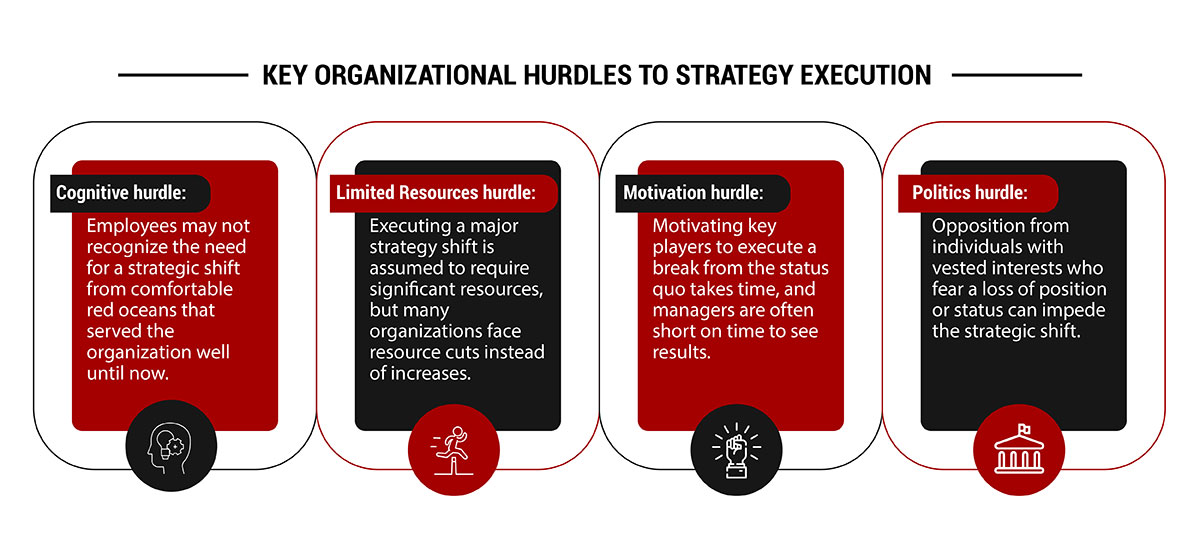After a company has successfully crafted a blue ocean strategy with a lucrative business model, the next critical step is its execution. However, executing any strategy can be a challenge, and companies, like individuals, often struggle to turn ideas into actions, whether operating in red or blue oceans.
Nonetheless, the blue ocean strategy represents a marked departure from the norm compared to the red ocean strategy. It centers on a shift from convergence to divergence in value curves while maintaining lower costs. This heightened focus on innovation raises the bar for successful execution.
Managers face four key organizational hurdles to strategy execution, they are:

Although the severity of these hurdles may vary across different companies, the ability to overcome them is essential in minimizing organizational risk. These organizational hurdles can present significant challenges, but they can be successfully navigated with the right strategies and approaches.
Let's learn each of these obstacles more closely and evaluate possible solutions to overcome them.
In the realm of turnarounds and corporate transformations, one of the most daunting challenges is convincing people of the necessity for a strategic shift and reaching a consensus on its underlying causes. Often, CEOs resort to presenting data and pushing for better results as a means of justifying the change.
However, it is widely acknowledged that figures can be manipulated, and striving for unrealistic goals can lead to budgetary malpractice. This, in turn, fosters animosity and mistrust between different factions of an organization. Furthermore, even when data is not intentionally altered, it can still be misleading.
For example, a company's financial reports may indicate impressive growth in revenue, but neglect to mention that this was achieved through unsustainable practices that will ultimately harm the organization in the long term.
In summary, while statistics and results can provide useful insights, it is crucial to exercise caution in their interpretation and implementation. CEOs and leaders must work to ensure that their teams are fully informed and aligned with the need for change before initiating any strategic shift.
Two Powerful Ways to Drive Change
Once an organization has acknowledged the need for a strategic shift and has come to a general agreement on the contours of the new strategy, leaders are faced with the harsh reality of limited resources. Acquiring more resources can be a lengthy and politically charged process, leaving leaders to wonder how to execute a strategic shift with fewer resources.
Instead of fixating on obtaining additional resources, business leaders can focus on multiplying the value of their existing resources. In situations where resources are scarce, there are three factors that can have a disproportionate influence on freeing up resources and multiplying their value. These factors include identifying hot spots and cold spots within the organization, as well as engaging in strategic horse trading. Strategic leaders can achieve significant results by leveraging these factors while working with limited resources.
To effectively implement the blue ocean strategy, it is crucial to communicate the need for a strategic shift to employees and devise a plan to achieve it with limited resources. In order to turn a new strategy into a movement, it is not enough for individuals to simply understand what needs to be done, they must also be motivated to take sustained and meaningful action.
However, motivating a large number of employees quickly and cost-effectively can be a challenging task. Traditional approaches often involve issuing grand strategic visions and implementing massive top-down mobilization initiatives, assuming that significant actions are necessary to create significant reactions. Yet, this approach can prove to be cumbersome, expensive, and time-consuming due to the diverse range of motivational needs within most large companies. Furthermore, overarching strategic visions often lead to mere lip service instead of the intended action.
Rather than dispersing change efforts broadly, consider taking the opposite approach by concentrating them heavily. By focusing on three key factors that hold a disproportionate influence in motivating employees - kingpins, fishbowl management, and atomization - you can effectively drive change within your organization.
Key influencers in an organization are known as "kingpins"
Fishbowl management is a powerful tool to motivate and engage kingpins
Atomization is another important factor in creating change within an organization
It is often misinterpreted that skill and youth tend to triumph over deceit and age. The presence of politics and plotting in organizations is an inescapable truth that even the most talented individuals may fall prey to. While an organization may have made significant strides toward achieving its goals, the existence of powerful interests can pose a serious threat to impending changes. As change becomes more imminent, the negative influencers, both within and outside the organization, become more vocal in their opposition, fiercely fighting to protect their positions. This resistance can severely hamper and even derail the process of executing strategies, thereby damaging the organization's prospects for success.
Here are three powerful factors that can help you achieve your goals:
Successful strategy execution is an extremely complex process, especially for organizations that work with limited resources. Nevertheless, strategic shifts can be actualized by overcoming the four major barriers and by focusing on factors that cause disproportionate influence. Avoiding a proportional response to every challenge can be a crucial element of leadership that aligns employees' actions with a new strategy, allowing for the successful implementation of a blue ocean strategy.

CredBadge™ is a proprietary, secure, digital badging platform that provides for seamless authentication and verification of credentials across digital media worldwide.
CredBadge™ powered credentials ensure that professionals can showcase and verify their qualifications and credentials across all digital platforms, and at any time, across the planet.

Keep yourself informed on the latest updates and information about business strategy by subscribing to our newsletter.